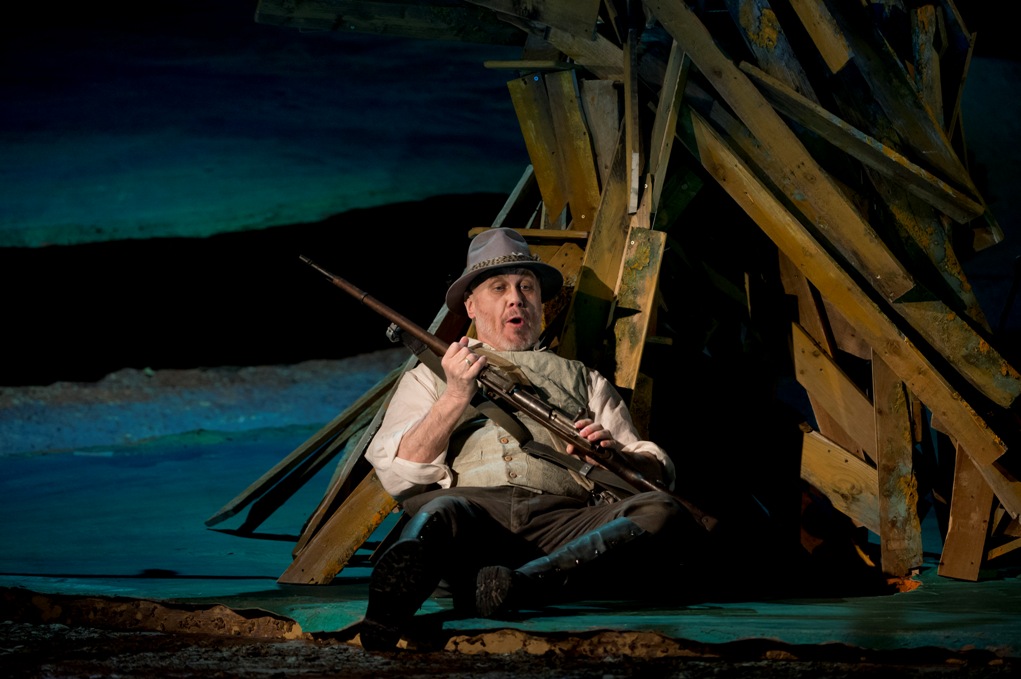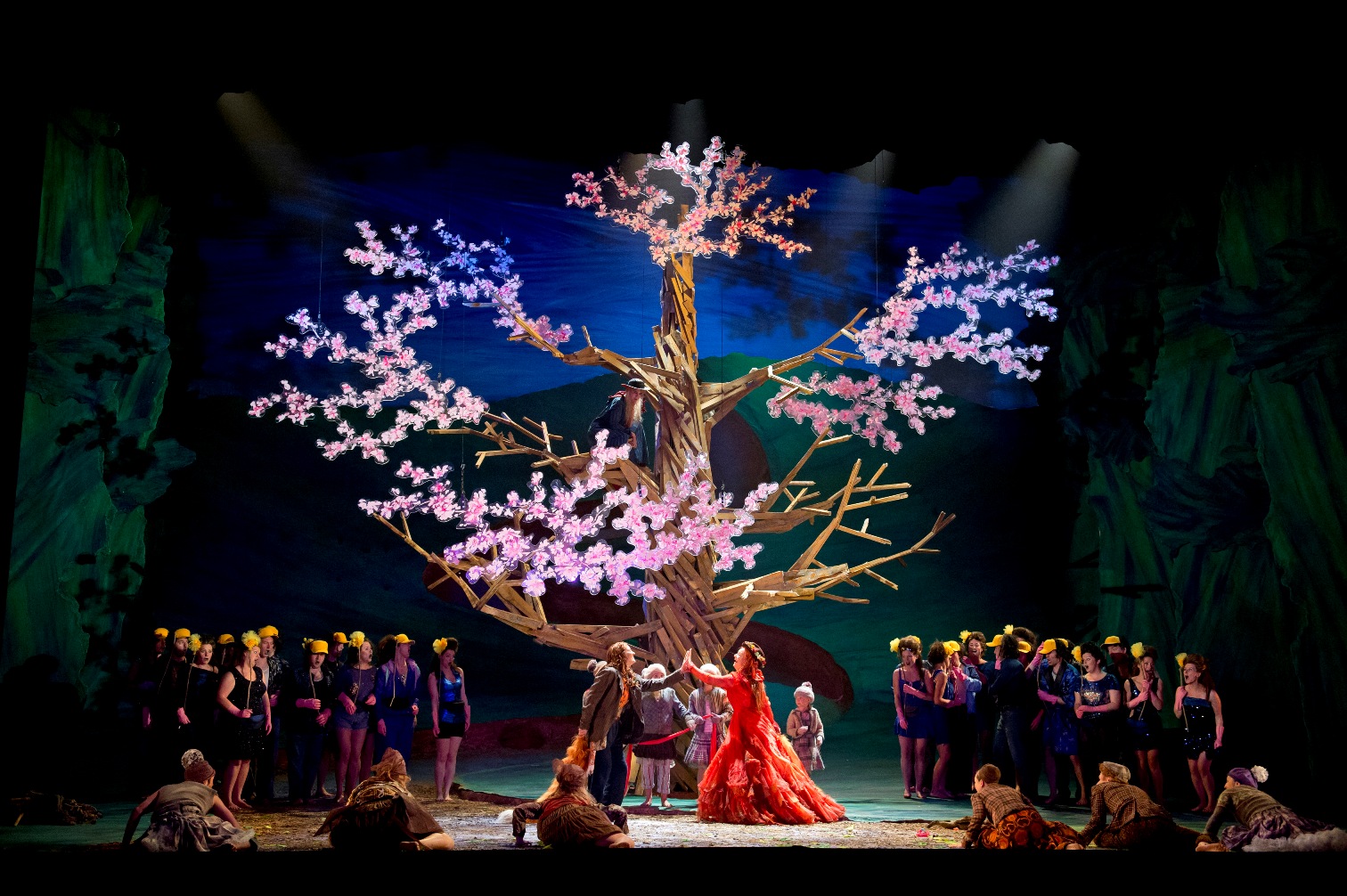Glyndebourne nature, it seems, runs along as smoothly as the much discussed new wind turbine on the hill. Within the theatre, though, all is flux: director Melly Still and Vladimir Jurowski, conducting an incandescent London Philharmonic Orchestra, show just how flexible it's possible to be with the viciousness and the vivacity in Janáček's kaleidoscope of birth, copulation, death and a redemption of sorts in celebration of the natural order.
What the composer challengingly called "a merry thing with a sad end" is not, as some past productions have played it, an animal fable for children. Vixen Sharp Ears is taken away from her natural habitat by the gruff Forester, creates murderous mayhem at his lodge, mates, breeds and dies of unnecessary bravado facing the barrel of a poacher's gun; all this can be comprehended and even accepted by kids. They're less likely to be impressed by ageing humans grappling with illusions and disillusionment - a downward spiral from which the Forester, unlike his village pals, eventually escapes by going back to nature.
At Glyndebourne there is no disappointment in the shift of mood from natural life around the central tree of Tom Pye's magical designs to grumblings down the pub. Jurowski paces his diaphanous orchestra perfectly from a light and airy start, woodwind glinting through leafy strings, to the surges of rapture for the Vixen's dreams of girlhood and an even more passionate rhapsody - what Janáček meant by it, who knows, but it's gorgeous - for the apparently disgruntled Forester once his catch has got away. The belated unleashing of the composer's more baleful sounds in his eerie writing for lower brass is chillingly realised as poacher Harasta (William Dazeley) stalks the forest at the beginning of the eventful last act.
 Rightly, the showiest energy belongs to the vulpine members of the cast. Lucy Crowe's restless Vixen is a wild child quick to assert her independence. The lustrous stops this gifted lyric soprano is able to pull out in a half-animal, half-human kind of courtship, where the earthiness is in the text and a deeper love-music glows in the orchestra, find their match in Emma Bell's ardent bohemian Fox. The Forester of veteran Sergei Leiferkus (pictured right) makes a different journey from brusque appropriation of nature to a mellow sense of reconciliation with it. Leiferkus can still rise to the lyric challenge of the great final scene in which his character perhaps learns to face death (his ultimate rest beneath the big tree is ambiguous, as it should be).
Rightly, the showiest energy belongs to the vulpine members of the cast. Lucy Crowe's restless Vixen is a wild child quick to assert her independence. The lustrous stops this gifted lyric soprano is able to pull out in a half-animal, half-human kind of courtship, where the earthiness is in the text and a deeper love-music glows in the orchestra, find their match in Emma Bell's ardent bohemian Fox. The Forester of veteran Sergei Leiferkus (pictured right) makes a different journey from brusque appropriation of nature to a mellow sense of reconciliation with it. Leiferkus can still rise to the lyric challenge of the great final scene in which his character perhaps learns to face death (his ultimate rest beneath the big tree is ambiguous, as it should be).
His sorry companions, doubled in the animal world as Janáček somewhat randomly decided they should be, are Mischa Schelomianski's lugubrious Priest and the Schoolmaster of Adrian Thompson, a model of clarity in tragicomic suffering. Terynka, the red-haired object of his affections with whom the Vixen is confused more plausibly than usual in this production, puts in an appearance towards the end when she marries Harasta and gets a new fox muff as a special present.
Costume designer Dinah Collin has fun with a feisty anthropomorphic view of the animal world, so long as you can work out who's supposed to be what: jumpered foxes hand-manipulating their bushy tails with uncanny dexterity, bobble-hatted rabbits, a tawdry showgirl line-up of hens dispatched by the Vixen along with their male chauvinist cockerel, a peasant cow no doubt called Marigold as she yields a rubber glove to be "milked" by the Forester, and bathing-suited flower maidens. The mix of pell-mell action with Maxine Doyle's choreography can seem a bit random, and not always entirely clear, least of all in the Vixen's ultimately fatal brinksmanship, but it's executed with spirit by a lively mixture of chorus, actors and children. It also fits as happily into Glyndebourne's relatively intimate scale as does the detailed shimmer of Jurowski's orchestra.
 The changing seasons, evocatively lit by Paule Constable, are effortlessly achieved. The softer, more picture-book effects of the greens and browns of late summer at the beginning and end as well as a spring flowering for the foxy wooing and wedding (pictured left) are interspersed with starker scenes: sheets of snow deck the perilous path that runs from top to bottom of the stage and doubles as the badger's sett occupied by the Vixen, and just after her death the tree turns blood-red before revealing itself in a harsher light as the pile of splinters that it is - a hint of nature's despoliation as powerful as the sense of ecological waste Still created in her equally perceptive Glyndebourne production of Dvořák's Rusalka. The final liberation, though, is unequivocal, the orchestra ringing out the bells of that "more than earthly joy" the Forester has sung about in his epiphany as his double mounts the winding path in extraordinary perspective. With any luck, you'll walk out into the sunshine of a Sussex evening sharing that exhilaration.
The changing seasons, evocatively lit by Paule Constable, are effortlessly achieved. The softer, more picture-book effects of the greens and browns of late summer at the beginning and end as well as a spring flowering for the foxy wooing and wedding (pictured left) are interspersed with starker scenes: sheets of snow deck the perilous path that runs from top to bottom of the stage and doubles as the badger's sett occupied by the Vixen, and just after her death the tree turns blood-red before revealing itself in a harsher light as the pile of splinters that it is - a hint of nature's despoliation as powerful as the sense of ecological waste Still created in her equally perceptive Glyndebourne production of Dvořák's Rusalka. The final liberation, though, is unequivocal, the orchestra ringing out the bells of that "more than earthly joy" the Forester has sung about in his epiphany as his double mounts the winding path in extraordinary perspective. With any luck, you'll walk out into the sunshine of a Sussex evening sharing that exhilaration.















Add comment